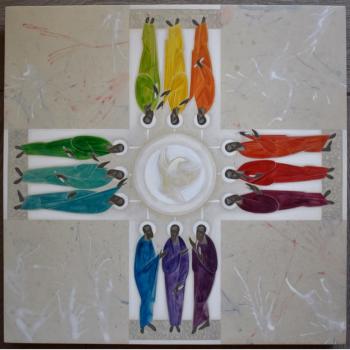Part 1 of a two-part series with unnecessarily long titles.
In an effort to lure the broadest readership to my fledgling blog, I couldn’t think of a better way to draw droves of folks in than to begin by reminding you that you are all going to die. Hence the potentially intimidating Latin-phrase-of-a-title that becomes actually intimidating when you realize what it means: remember you gon’ die, son (a rough translation). Happy New Year, y’all!
For our first adventure of the new year, The Suz and I visited the Frick Collection in NYC to see the Dutch Masterpieces on loan from the Royal Picture Gallery Mauritshuis in the Hague before they make their way home on the other side of the pond. As much as I enjoyed Vermeer’s ever so famous and intriguing Girl with a Pearl Earring and Fabritius’ tiny Goldfinch, I found myself most drawn to Peter Claesz’s Vanitas Still-Life (1630).
The inspiration for Claesz’s title Vanitas undoubtedly comes from Ecclesiastes (a fascinating read, if you’ve not had the pleasure). Perhaps best read not when you’re teetering on the edge of a precipice of sadness but, then again, I could be wrong: gaudium est miseris socios habuisse penarum [it is a comfort to the wretched to have companions in woe]. The author of Ecclesiastes reflects upon the vanity of life, its fleetingness, sometimes its seeming futility and meaninglessness:
Vanity of vanities, says the Preacher, vanity of vanities! All is vanity. What does man gain by all the toil at which he toils under the sun? A generation goes, and a generation comes, but the earth remains forever. The sun rises, and the sun goes down, and hastens to the place where it rises. The wind blows to the south and goes around to the north; around and around goes the wind, and on its circuits the wind returns. All streams run to the sea, but the sea is not full; to the place where the streams flow, there they flow again. All things are full of weariness; a man cannot utter it; the eye is not satisfied with seeing, nor the ear filled with hearing. What has been is what will be, and what has been done is what will be done, and there is nothing new under the sun. Is there a thing of which it is said, “See, this is new”? It has been already in the ages before us. There is no remembrance of former things, nor will there be any remembrance of later things yet to be among those who come after. (Ecclesiastes 1:2-11)
That’s about as cheery as Claesz’s painting. The painting is an example of a memento mori – a painting that reminds us of our mortality. In Vanitas Still-Life, Claesz’s paints several objects on a table: a skull, a human bone (femur?), a timepiece, an emptied, upturned glass, an extinguished candle exhaling its final wisp of smoke and, what I find most interesting, a key hung on a brilliant blue lanyard.
These symbolism of the first several objects seem pretty straight forward: when you see bones, you see dead people (read in the voice of Haley Joel Osment); the timepiece indicates the limits of time and finitude of existence; the upturned glass symbolizes a life poured out (or the time “to drink and be merry” has now passed or you missed “final call”); and the smoke symbolizes the ephemerality of life. The key, on the other hand, doesn’t seem so obvious and, what is more, Claeszs draws our gaze to it by painting the lanyard with a rich blue in the midst of an otherwise pallid palette of browns and grays.
Perhaps he’s suggesting that the clue to benefitting the most from this reminder of our mortality relates to time. If you look closely, you’ll see that the key dangles over the edge, barely making it in the frame, the weight of which would pull it down if it were not for the lanyard held secure by the timepiece. For Claesz, time and the key are closely linked.
I was moved by this painting not because it delivered some sort of ominous omen (we all know we’re going to die) but because it offers a key to how to best avail ourselves of this reminder: time. Of all the limited resources at our disposal, time is the most precious (well, perhaps potable drinking water, for without that we’d all have just about three days time left). So I ask myself: how am I using my time? Am I taking advantage of the absolute gift of life or am I squandering it away on vanities? What is a good use of my time? What is a waste of my time? All good questions. Seeing Claesz’s Vanitas on loan for such a short season came as a timely reminder to inventory my life. I’m still taking stock.
I’ll go ahead and take the morbidity up a notch (or perhaps down a foot?) and say that this is why I like to have my local neighborhood cemetery serve as a regular haunt of mine. When we lived on the North Shore of Boston, the loop of the Hamilton town cemetery was often the final leg of our evening stroll. Romantic, right? We’d read the weathered carvings that memorialize an entire life in a few dozen words and wonder what we’ll have on our headstones, what we’d like our story to be. We’d also remind ourselves that life is short, hopefully sweet and wonderful, but certainly short.
While walking through the Princeton Cemetery the other day (conveniently located right around the corner from our apartment), we visited the grave of Jonathan Edwards (1703-1758) in the President’s Lot. Edwards, a theological hero, was the third president of Princeton University (then called the College of New Jersey). He died some thirty-four days into his presidency after succumbing to small pox, which he contracted through an attempted inoculation. Life’s short and takes surprising twists and turns. If you haven’t spent some quality time in a cemetery recently, I strongly suggest you do so at your earliest convenience. Memento mori.
So, here’s my point: thinking about death is good for your life. In fact, I could argue that this is simply the logical procession of Stephen Covey’s second habit of highly effective people: “begin with the end in mind.” Do you want to be a highly effective person? Walk through a cemetery, envision what you want on that gravestone, reflect upon what you want those you cherish most in this life to say about you, and then work your way backwards.
I think that’s what this painting has inspired me to do: begin 2014 with the end in mind. I hope I do this every year. At the end of the day, unless you know where you’re headed, it’s unlikely that you’ll ever arrive.
Click here to read Part 2 of this two-part series with unnecessarily long titles on time.











